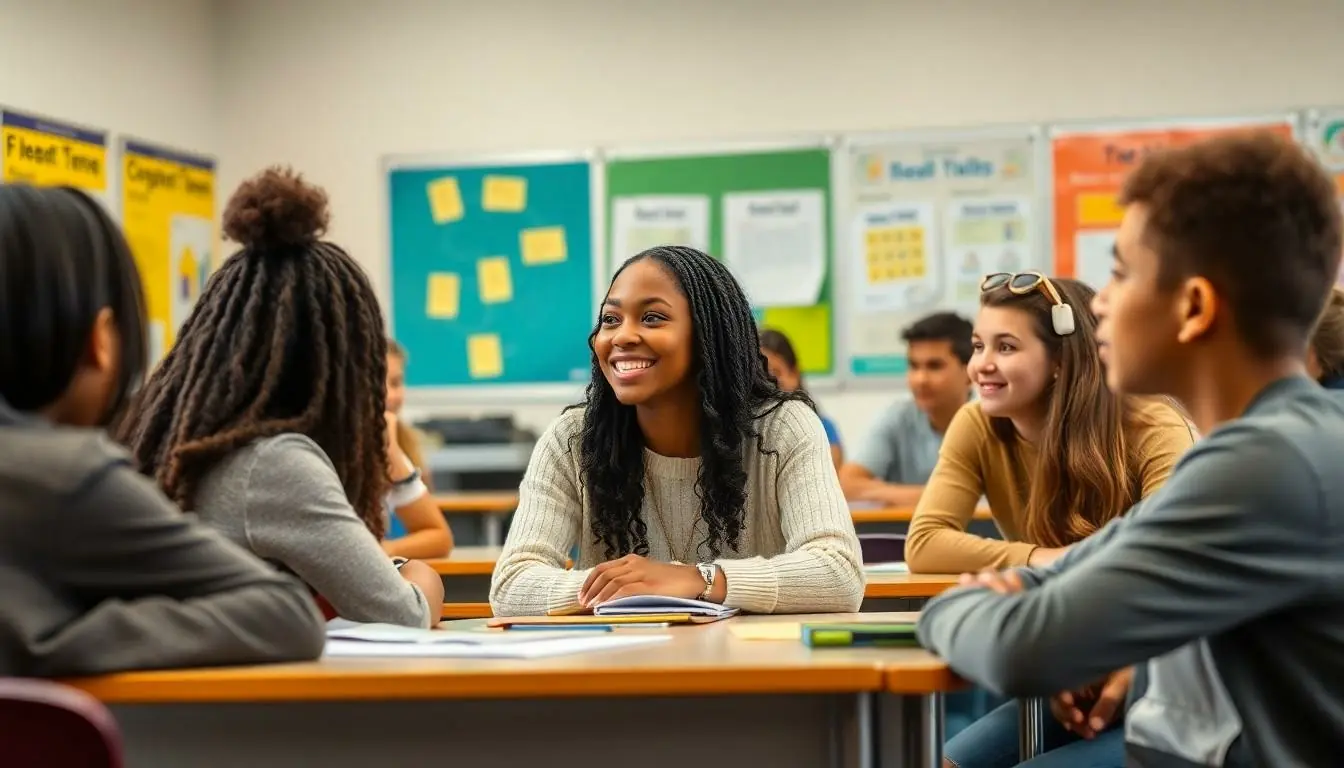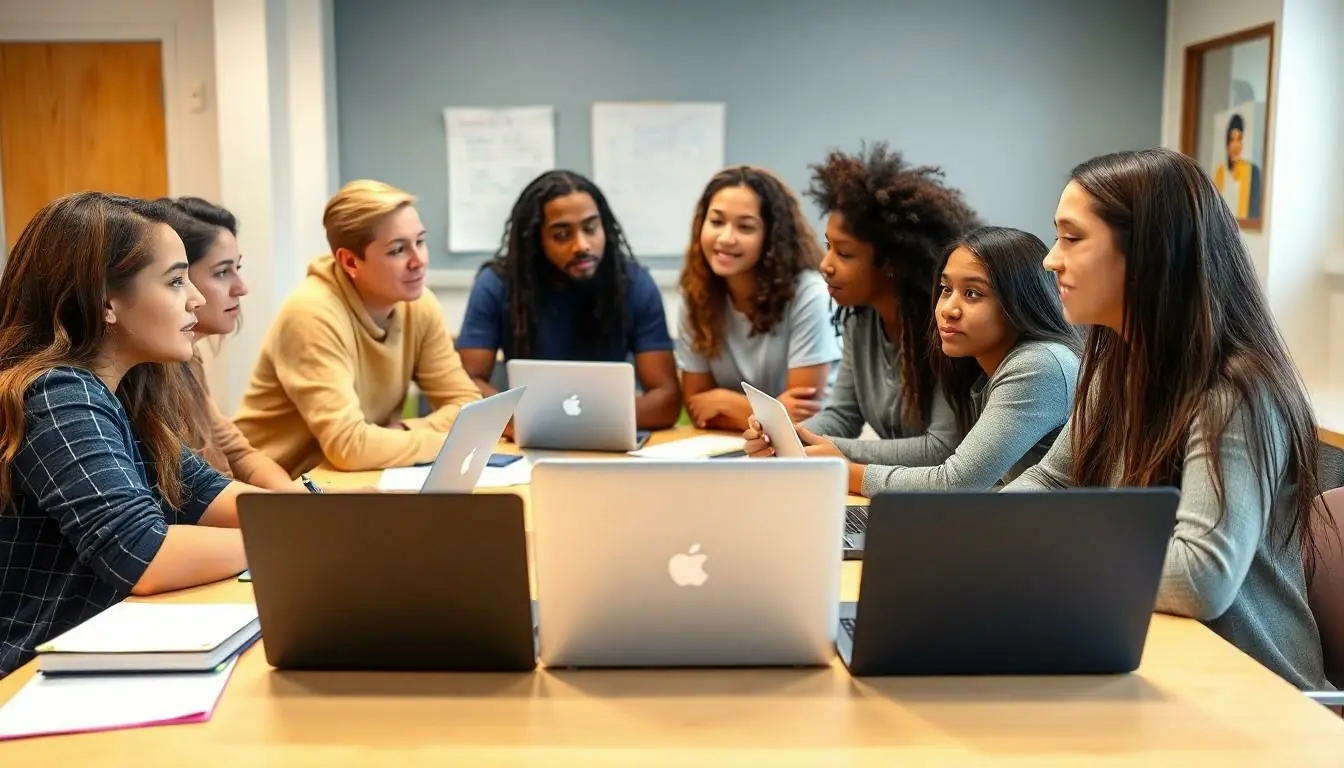In the bustling world of education, student feedback often gets overlooked like that last slice of pizza at a party. Yet, it holds the secret sauce for improving teaching methods and enhancing the overall learning experience. Imagine a classroom where students feel empowered to voice their opinions—it’s like turning on the lights in a dark room.
When students share their thoughts, it’s not just a chance for teachers to pat themselves on the back or cringe at critiques. It’s a golden opportunity to foster a culture of growth and innovation. So, why not dive into the vibrant world of student feedback? It’s time to transform those scribbled notes into actionable insights that can elevate education to new heights. After all, who wouldn’t want to create a classroom where every voice matters?
Table of Contents
ToggleUnderstanding Student Feedback
Student feedback serves as a critical tool for enhancing educational practices. It offers insights that help educators improve their teaching strategies and create better learning environments.
Definition of Student Feedback
Student feedback refers to the input students provide regarding their learning experiences. This input includes opinions on teaching methods, course content, and overall classroom dynamics. Feedback encompasses various forms, such as surveys, informal discussions, and anonymous suggestions. Educators utilize this information to gauge student understanding and determine areas needing reevaluation or enhancement.
Importance of Student Feedback in Education
Student feedback plays an essential role in shaping effective educational practices. Engaging students in the feedback process encourages active participation and ownership of their learning. This input helps teachers identify successful strategies and areas requiring adjustments. Moreover, responding to feedback fosters a trusting relationship between students and teachers. An environment that values student voices promotes collaboration and innovation, leading to improved academic outcomes. Emphasizing student feedback contributes to a responsive and inclusive educational experience.
Types of Student Feedback
Student feedback can take various forms, with each type serving unique purposes in the educational process. Understanding these types helps educators tailor their approaches to enhance student experiences and outcomes.
Formative Feedback
Formative feedback occurs throughout the learning process. This type involves continuous input from students that guides instructional practices. It typically takes the form of quizzes, classroom observations, or discussions. Educators use formative feedback to assess student understanding and adjust teaching methods accordingly. Encouraging students to share thoughts in real time fosters engagement and allows for immediate improvements. Regular check-ins help clarify concepts and direct further learning, building a supportive learning environment. Utilizing formative feedback enhances both teaching effectiveness and student growth.
Summative Feedback
Summative feedback assesses student performance at the end of a learning period. This feedback type focuses on evaluations like exams, projects, or final grades. It provides a comprehensive view of student achievement and mastery of content. Educators analyze summative feedback to identify trends and areas for improvement in their teaching strategies. Often, this feedback influences curriculum design and instructional decisions for future classes. Collectively, summative assessments serve as indicators of student learning effectiveness, helping educators make data-driven improvements. Immediate feedback can also inform students of their strengths and weaknesses, guiding future learning paths.
Collecting Student Feedback
Collecting student feedback enhances teaching strategies and shapes a beneficial learning environment. Various methods exist for obtaining this valuable input.
Methods of Collection
Surveys serve as a common tool for gathering student feedback. Educators often use these structured questionnaires to uncover insights into student experiences. Informal discussions allow for spontaneous exchanges where students can voice their thoughts. Additionally, suggestion boxes capture anonymous input, encouraging honest responses. Learning management systems often integrate feedback features, streamlining the process of collecting data. Each of these methods plays a significant role in understanding student perspectives, guiding instructional improvements.
Best Practices for Gathering Feedback
Making feedback collection regular creates consistency in engagement. Educators should ensure anonymity to foster honest responses, as students may feel more comfortable sharing candid opinions. Timing feedback requests appropriately maximizes participation; asking for input shortly after lessons encourages immediate reflections. Clear, specific questions guide students to provide relevant feedback. Following up on collected feedback demonstrates that educators value student input. Actively incorporating suggestions into teaching practices strengthens the student-teacher relationship. These best practices contribute to a more inclusive and responsive educational environment.
Analyzing Student Feedback
Analyzing student feedback involves examining the data collected to enhance educational practices. Understanding both qualitative and quantitative aspects provides deeper insights into student experiences.
Qualitative Analysis
Qualitative analysis focuses on understanding the thoughts and feelings conveyed in student feedback. It involves interpreting open-ended responses and feedback from discussions. Educators gain insights into student concerns, preferences, and suggestions by analyzing these responses. For example, comments from suggestion boxes may reveal specific areas where students feel improvements could be made. Analyzing patterns across multiple submissions helps identify common themes, enabling targeted adjustments to teaching strategies. Actively engaging with qualitative feedback promotes a healthier learning environment and builds trust between students and educators.
Quantitative Analysis
Quantitative analysis deals with numerical data collected through structured surveys and assessments. It encompasses measuring student feedback using scales or ranking systems to gauge satisfaction levels. Analyzing responses statistically uncovers trends in student experiences, highlighting strengths and weaknesses in teaching methods. For instance, if 75% of students report satisfaction with interactive lessons, this indicates effective teaching practices. Conversely, if 60% express dissatisfaction with assessment methods, it signals the need for improvement. Employing quantitative analysis provides clear metrics, helping educators make informed decisions that enhance overall learning outcomes.
Utilizing Student Feedback for Improvement
Student feedback serves as a crucial element for growth in educational settings. When utilized effectively, it transforms teaching and learning experiences.
Enhancing Teaching Strategies
Adjusting teaching methods based on student feedback leads to more effective instruction. Continuous input during lessons, such as by incorporating classroom discussions, allows educators to respond dynamically. Observations from informal conversations can provide insights into student engagement. Implementing adjustments from formative feedback promotes active learning. Teachers become more attuned to diverse learning styles, resulting in tailored approaches that resonate with students. This adaptability helps motivate students and fosters a more interactive classroom environment.
Improving Course Content
Course content benefits significantly from student feedback, which highlights areas needing enhancement. Collecting input through structured surveys reveals specific preferences and challenges encountered during the learning process. Analyzing qualitative data from open-ended responses uncovers topics that require more depth or clarity. Feedback also informs curriculum design, ensuring alignment with student interests and career aspirations. Integrating suggestions into future course iterations enhances relevancy and engagement. Fresh perspectives from students create a curriculum that is both responsive and reflective of their needs.
Conclusion
Embracing student feedback is essential for creating a dynamic educational environment. By actively seeking and valuing student input, educators can foster a culture of collaboration and innovation. This approach not only enhances teaching strategies but also empowers students to take ownership of their learning experiences.
Incorporating both formative and summative feedback allows for continuous improvement and adaptation in the classroom. As educators respond to student needs and preferences, they pave the way for more engaging and relevant curricula. Ultimately, prioritizing student voices leads to a more inclusive and effective learning atmosphere where everyone can thrive.





